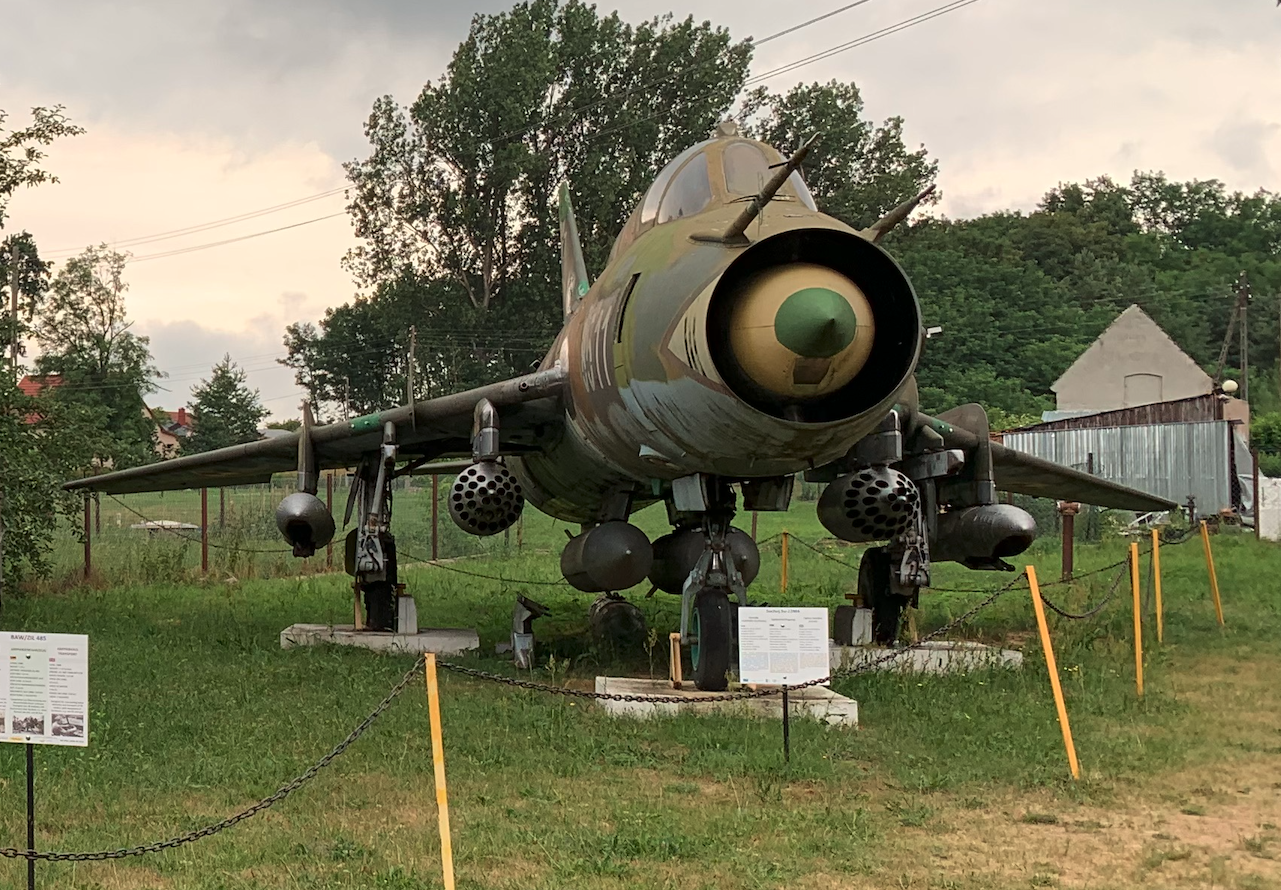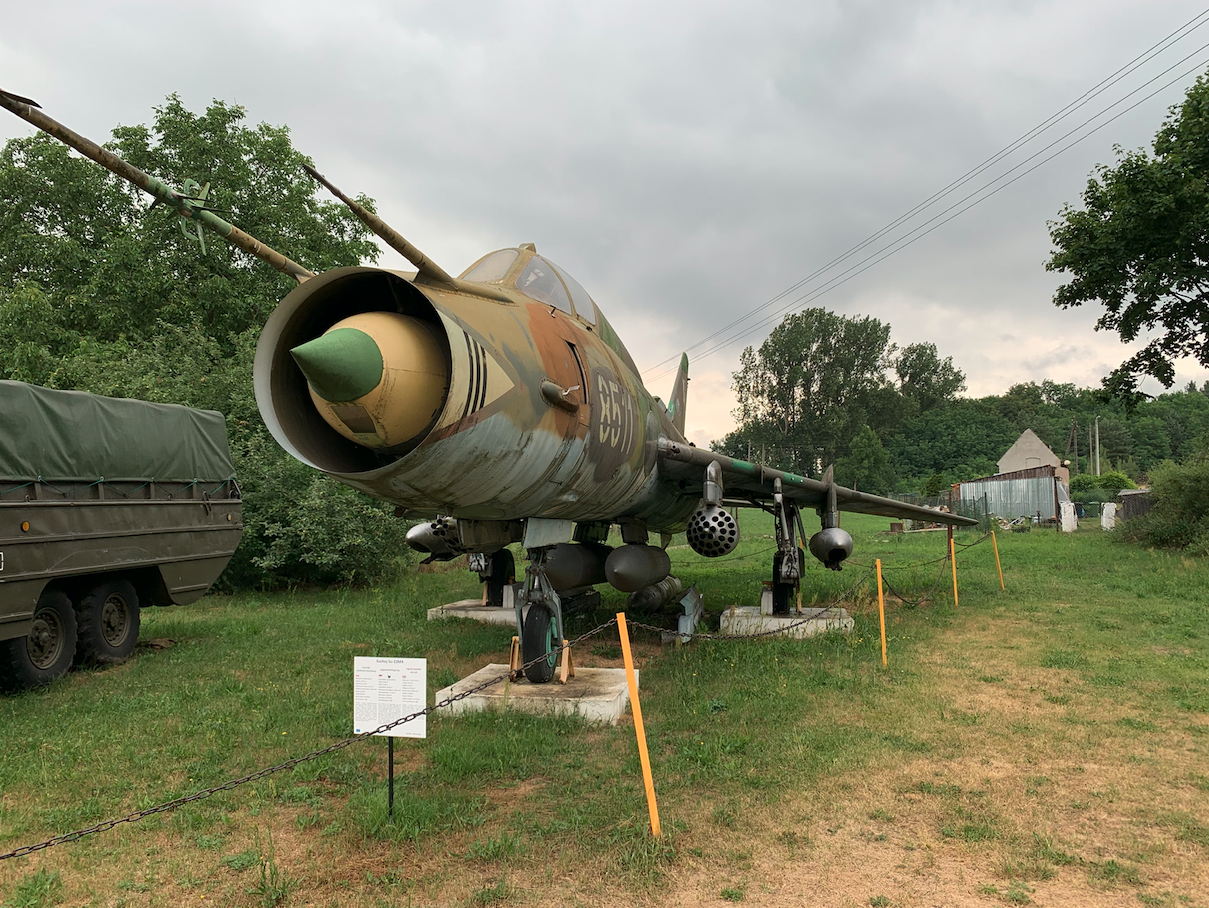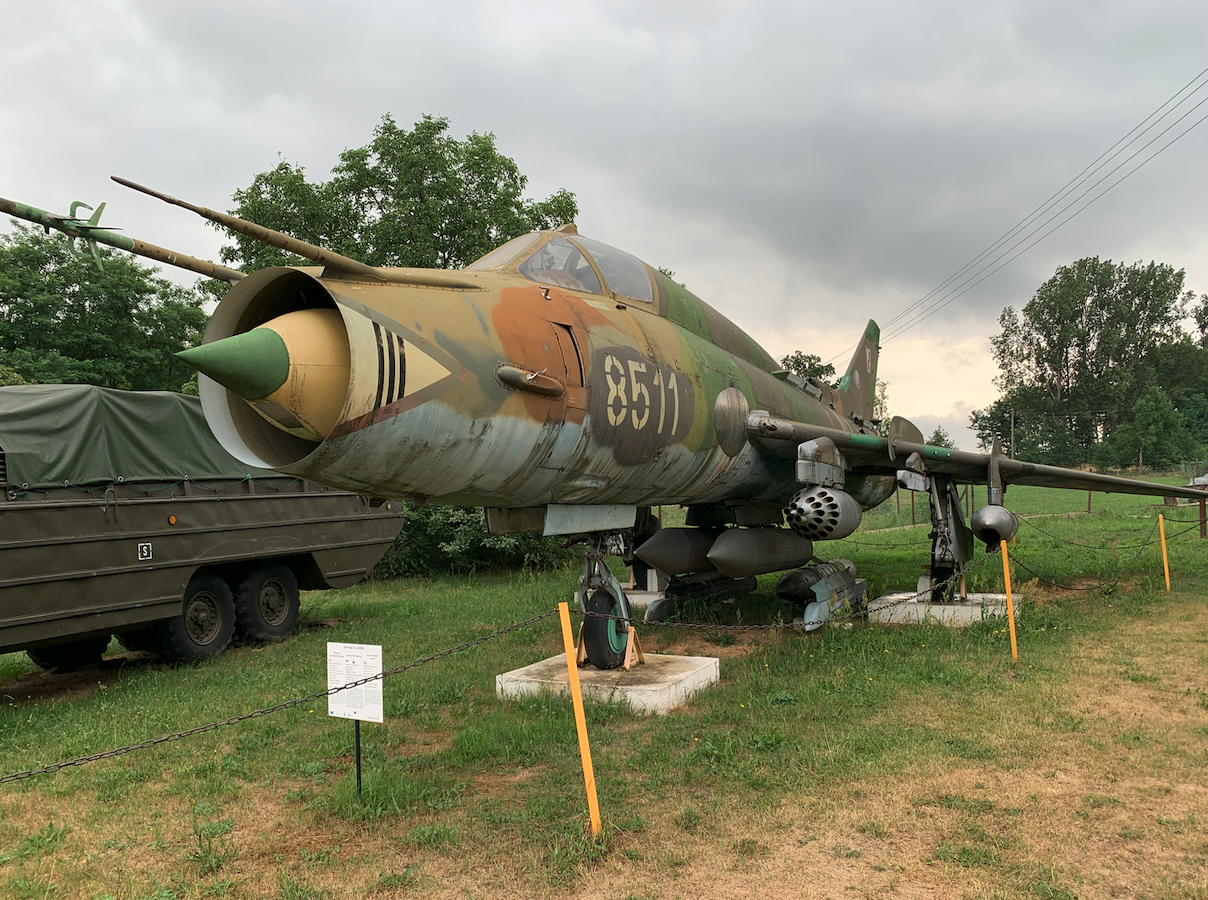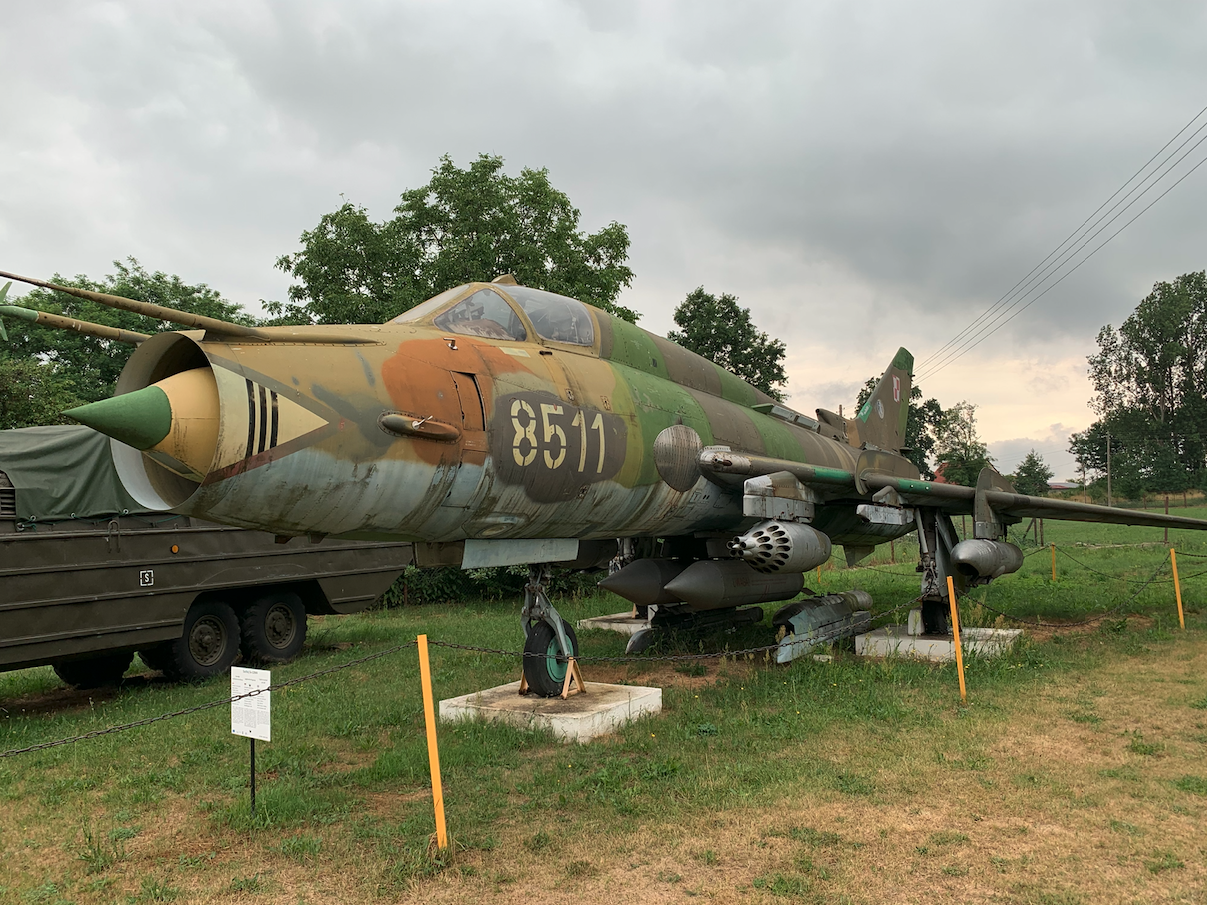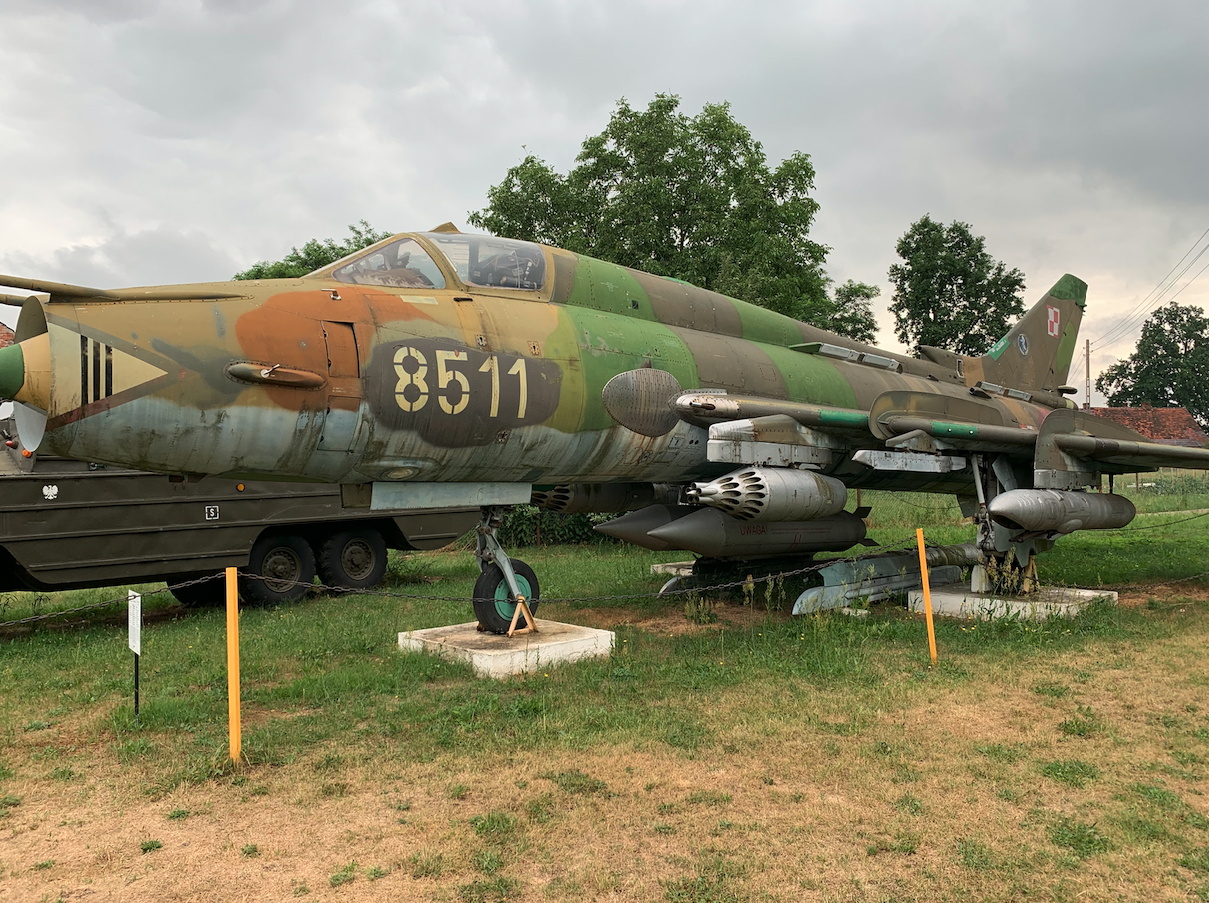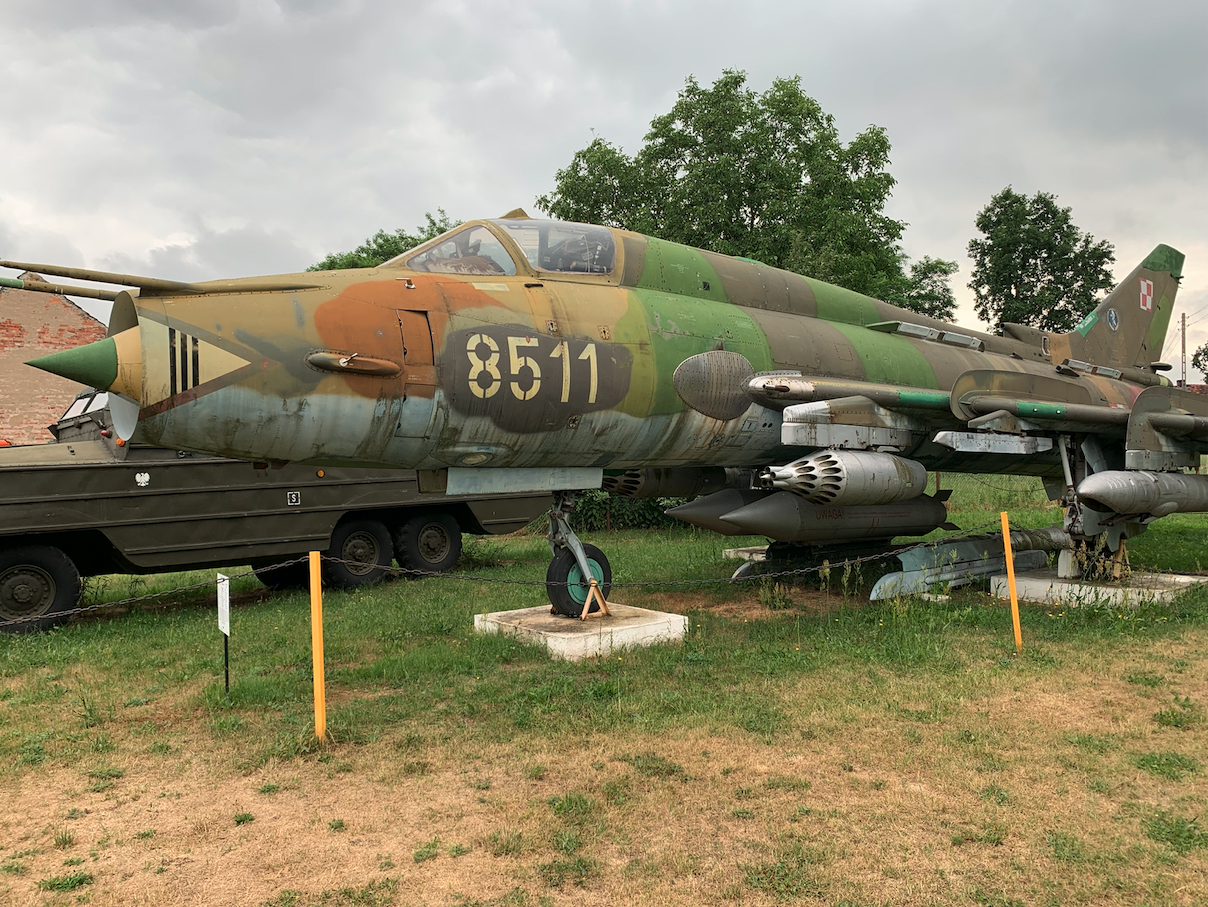Drzonów 2022-07-26
Attack plane Sukhoi Su-22 M4K nb 8511.
The Sukhoi Su-22 M 4 K 8511/28511 plane was the 73rd plane purchased by Poland. The plane was delivered in 1986. The plane was used in Powidz. The main renovation was carried out in 1994-08-02. In 2006, the plane was out of service. In 2008, the plane found its way to the Museum in Drzonów – Lubuskie Military Museum.
The history of the purchase of Su-22 M 4 K and Su-22 UM 3 K aircraft for the Polish Army.
The outbreak of the Second Cold War, in the early 1980s, forced the rearmament of the Warsaw Pact countries. In Poland, underdeveloped MiG-23 MF planes and MiG-21 bis planes were introduced into the service of fighter aviation in a limited number.
However, the real retooling took place in the fighter-bomber (assault, strike) aviation. And in terms of quality and quantity. Poland bought Su-22 planes in two versions; single-seater Su-22 M 4 K and two-seater Su-22 UM 3 K. In 1985, the Polish Army received the first 20 and 6 cars, respectively. In total, 90 single-seater planes and 20 two-seater planes were purchased, which made 110 copies, i.e. equipment for three aviation regiments and one squadron.
The Su-22 M 3 aircraft competed with the MiG-23 BN for deliveries to Poland. In 1982, the Sukhoi plane was selected for economic reasons. At that time, however, the purchase decision was not made. In 1983, the Soviets offered to buy a newer version of the aircraft, namely the Su-22 M 4, and then an order was placed for 80 Su-22 M 4 and 20 Su-22 UM 3 K for two fighter-bomber regiments and two squadrons of the 7th BLR- B (Bomb and Reconnaissance Aviation Brigade). In 1986, 20 more Su-22 M 4 planes were ordered to equip the third regiment with this type of machine (8th PLM-B from Mirosławiec) in place of two squadrons of the 7th BLBR (Su-20 planes remained in it).
In the period August – October 1984, the first 13 aircraft reached Powidz on board Ił-76 and An-12/22. There were 7 Su-22 M 4 machines (nb 3005, 3212, 3213, 3908-3911) and 6 training and combat Su-22 UM 3 K machines (104, 305-308, 509). All planes were part of the 6th PLM-B (fighter-bomber aviation regiment) in Piła, in August 1985, the 40th PLM-B from Świdwin received its first Su-22, and in May 1986, the third squadron of the 7th PLB- R (bomber and reconnaissance regiment) from Powidz (initially this squadron was to be part of the 8th PLM-B in Mirosławiec).
In May 1985, the first group of pilots and technicians went to Krasnodar for training on new equipment. The soldiers returned to Poland in July 1985.
Deliveries of the Su-22 were carried out differently than the Su-20 planes that simply flew in 10 years earlier. The Su-22 was delivered to Powidz in boxes. Here, the Soviets assembled and flew the equipment themselves. Only then did they pass it on to the Polish side. Probably the first Polish Su-22 M 4 in Powidz flew on 1984-05-05. The technical service life of the Polish Su-22 during the peace period was 20-25 years.
Some of the first pilots were; Lt. Col. Bogdan Likus, Jan Kania and Zenon Jankowski (Polish cosmonaut’s understudy).
The first unit equipped with new aircraft was the 7th PLMB from Powidz. The next ones are the 6th PLMB in Piła and the 8th PLMB in Mirosławiec. Each of the units received 36 machines for 3 squadrons (in accordance with the posts at that time).
The first period of use of the new machines fell in the second half of the 80-year period. Polish pilots mastered the pilot relatively quickly and already in the first years of operation made take-offs and landings at the DOL (road airport sections). Combat training was conducted at the Nadarzyce training ground and at the maritime training ground near Ustka. The training with the use of the new p-z class guided armament (air-to-ground, air-to-water, and in accordance with the changed air-surface nomenclature) was particularly important. Since the Polish state was firmly in the Warsaw Pact, the tasks set for the new machines remained unchanged.
As of 1991-01-01, there were 85 Su-22 M 4 K and 19 Su-22 UM 3 K in service. We lost 2 pilots and 3 Su-22 M 4 K and 1 Su-22 UM 3 K.
The socio-political changes in Poland, which began in 1989, made Poland strive to join the North Atlantic Alliance (NATO), which finally took place in 1999. But from the beginning of the nineties, Poland was looking for its subjectivity in new conditions. It manifested itself, inter alia, in making contacts with recent opponents. In 1995, pilots from Powidz on Su-22 planes visited the Swedish base in Satenas for the first time.
In the 90 years, Polish Aviation received new tasks. In order to perform them effectively, it was necessary to regroup forces. The result was the liquidation of the Su-22 aircraft base in Piła and its transfer to Świdnica. As a result, the Su-22 planes were more evenly distributed, although correctly the Su-22 planes had to be transferred to the airport in Biała Podlaska. Our recent surveillance has become our opponent. Joining NATO influenced a new division of air divisions. The regiments disappeared and the squadrons became the basic organizational unit. According to the agreements, Poland should have ten tactical aviation squadrons.
After Poland joined NATO, the Su-22 planes were adapted to operate in their structures. First, the radio panel was replaced so that the communication mode used in NATO could be used. The next step was to replace the navigation equipment. However, it should be remembered that the Polish Su-22 has never been adapted to operate outside our country. Even then, the operation of the aircraft was expected until around 2015.
In 2000-01-01, the Polish Army was armed with 80 Su-22 M 4 K and 18 Su-22 UM 3 K, respectively, and constituted a significant force. In the 90 years we lost 4 pilots, 5 single-seater and 1 two-seater. In 2000, the planes were grouped in 5 squadrons; in Świdwin, Mirosławiec and Powidz. About 20 machines were gathered in each squadron.
Poland has a complete technical base for repairs. The engines are being renovated in Warsaw. Airframes in Bydgoszcz.
The Su-22 combat aircraft were operated in Powidz, Mirosławiec, Piła (until 2000), Świdwin, and in schools in Mińsk Mazowiecki and Dęblin. The DOL was used, most often the DOL-Klinisko. The planes flew over the training grounds in Nadarzyce and Ustka.
The accident rate of Su-22 aircraft was not greater than that of other types. Not many accidents happened. By 2007, we lost a total of 8 pilots and 12 machines, including two two-seater machines. In 2007, a decision was made to terminate the operation in the period 2011-2012, i.e. until the technical resources are exhausted.
In accordance with the "Development Plan for the Armed Forces for 2005– 2010", in 2008, we will operate 48 Su-22 aircraft, which constitute the armament of three tactical aviation squadrons.
In 2012, WZL in Bydgoszcz presented a modified version of the Su-22 aircraft intended for the Navy aviation. The presented plane was a copy of Su-22 M 4 K nb 9305. The plane received the equipment necessary for flights over the sea and counteracting surface targets. In addition, the plane received a new camouflage consisting of two shades of gray. The Polish Army did not express any interest in the proposal. At that time, Poland had an excess of Su-22 aircraft, which were stored, mainly in Świdwin.
In 2015-2018, Su-22 aircraft should be decommissioned. However, in February 2014, the head of the Ministry of National Defense, Tomasz Siemoniak, decided to keep them in the 40th ELT, 21st Air Base in Świdwin. It was decided to renovate them, which allowed them to remain in service for the next 3-10 years. The modernization covered 6 Su-22 UM 3 K and 12 Su-22 M 4 K aircraft. The planes were initially verified and then flown to Bydgoszcz. The planes received a new radio station, on-board instruments in Anglo-Saxon units, the aggregates were repaired or replaced. At the same time, the planes received a new camouflage, the so-called pigeons. The first Su-22 M 4 K nb 8205 aircraft was handed over to the military in May 2015. The renovation of the remaining aircraft lasted until the end of 2016.
Many Su-22 planes were handed over to museums. The planes can be found in Warsaw, Dęblin, Kraków, Poznań, Drzonów, Museum 303 in Napoleon and other places.
List of modernized aircraft:
Su-22 UM 3 K nb 308, 310, 508, 509, 706, 707.
Su-22 M 4 K nb 8205 (first modernized), 3201, 3304, 3612, 3706, 3713, 3715, 3920, 7410, 8101, 8309, 8920.
Written by Karol Placha Hetman

